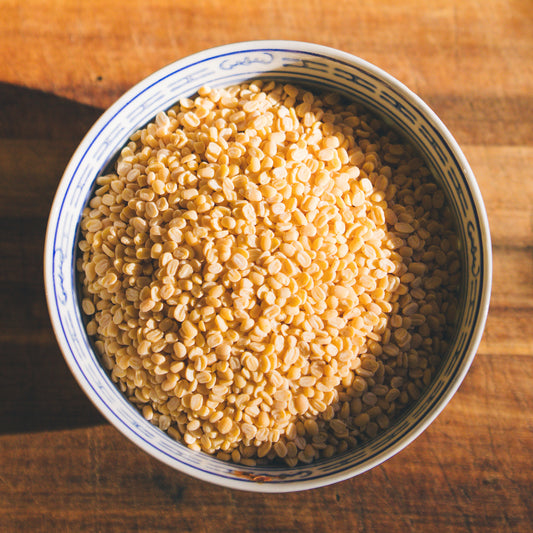Ayurvedic Food Combining
Combining Foods for Better Digestion
For many, the concept of food combining—the idea that some foods digest well together while others do not—is entirely new, and somewhat foreign. But according to Ayurveda, it is an essential part of understanding how to eat properly, just as discovering one's constitution and state of imbalance is important for one's Ayurvedic self-discovery.
Careful food combining can dramatically improve the quality of digestion, support the body in receiving a deeper level of nourishment, and positively impact our overall health. However, most people in the modern world are accustomed to eating a number of foods that do not usually digest well together (like fruit with nuts, or beans with cheese).
So why does it matter? The Ayurvedic perspective on diet is that each food has a distinct combination of tastes and energies—and a corresponding effect on both the digestive system and on the body as a whole.
Combining foods with radically different energetics can overwhelm the digestive fire (agni) and can cause indigestion, fermentation, gas, bloating, and the creation of toxins. 1 This is why proper food combining is so important.
Of course, certain combinations disturb the digestive tract more than others—an important consideration if this practice is entirely new to you. Regardless of your particular habits or symptoms, paying attention to how you combine foods can provide a valuable opportunity for insight, healing, and improved health.
Remember, food combining is not about imposing black and white rules. It is one of many powerful Ayurvedic tools for improving digestive health and overall wellness.
A Balanced Approach to Food Combining
It is usually best to embrace the idea of food combining slowly and gently, allowing plenty of time to make the necessary adaptations. Some of the recommended adjustments are relatively simple; others can require a major recalibration in our habits, or be met with resistance.
Often, simply developing an awareness of the improper food combinations that you eat somewhat regularly is a great place to start. Notice which foods you combine that may be difficult to digest together, and how often you indulge in them. Become aware of how you feel afterward. Do these choices affect your energy level, your digestion, your elimination, the coating on your tongue? Are particular combinations more noticeably influential than others?
These are all important pieces of information. They can confirm the importance of proper food combining and can help each of us to identify the food combinations that are the most disruptive to our systems.
When you are feeling motivated and decide that you are ready to start adapting your diet to accommodate more supportive food combinations, consider tackling just one change at a time. Perhaps you'll start by eating fruits alone, rather than in combination with other foods.
Over time, you can gradually progress toward the ideal. While it would certainly be nice to avoid improper food combinations altogether, reducing their frequency can also be incredibly beneficial. If you do find that some specific food combinations are more problematic for you or your loved ones than others, focus your efforts on changing just those in the beginning.
The most important first step is to become aware of your needs and your habits; from there, you can evolve an approach to food combining that works for you.
Food Combinations to Avoid or Reduce
The following food combining chart highlights incompatible food groups and offers suggestions for more appropriate combinations. It is meant to be a helpful guide, not an exhaustive list. In fact, you may be aware of other combinations that do not work for your body. Honor those instincts.
For the incompatible food combinations listed here, you may wonder how long you should wait between consuming each separate food. Everyone's digestion is different—some people are fine with waiting half an hour while others need an hour or two between meals. We encourage you to start out with waiting an hour and seeing how that works for you. You may find that you need more or less time, depending on your constitution or state of balance.
Because this resource is meant to help you determine optimal combinations at a glance, there is some repetition. Combinations listed in all caps are particularly challenging.

Yes, some of these are staple combinations in many households. Pizza and a number of other beloved Italian dishes combine nightshades with cheese. And who among us hasn't enjoyed beans with cheese at some time or another?
Then there's the fruit and yogurt taboo… So much for about 80% of all available store-bought varieties of yogurt; next time you indulge in a fruit-flavored yogurt, pay attention to how your digestion feels afterward. This goes for coconut yogurt and other alternative yogurts as well!
In addition, there are some specific preparations that are challenging when combined with particular foods.

The rules laid out on this food combination chart may feel overwhelming—even irritatingly complicated. But, the rationale behind proper food combining really does make sense. Ultimately, combining mismatched foods generates ama, a toxic substance that is often at the root of imbalance and disease. 2
For those of you who would like to understand a little more about HOW and WHY these food combinations tax our bodies, here are a few specific examples:
Bananas and Milk
Though commonly eaten together, bananas and milk are challenging to digest together because their qualities are so different. Bananas are heating while milk is cooling. That alone is problematic. Further, bananas become sour as they break down. So now our digestive fire has to process a sour substance and milk at the same time.
Ever added a squeeze of lemon to milk? Or maybe you've poured a little milk into a tangy, fruity tea… only to watch it curdle instantly? What happens to these mismatched foods in the digestive tract is not much different.
When bananas and milk are eaten together, their opposing qualities tend to smother the digestive fire and can disrupt the balance of intestinal flora, which results in the creation of toxins. This combination also frequently causes congestion, colds, coughs, allergies, hives, and rashes. 2 A similar situation arises when we combine any sour fruit with milk. 3
You may be wondering if this goes for alternative milks as well, such as almond milk or oat milk. Because fruit does not combine well with nuts or grains, the same rules do apply.
Nightshades and Cheese
This combination is simply too taxing for the digestive fire. A nightshade is a common name for a member of the plant family Solanaceae, which includes potatoes, bell peppers, tomatoes, eggplants, cayenne peppers, paprika, tobacco, henbane, belladonna, datura, and over 2,500 other plants.
Nightshades contain alkaloids, primarily as a means of defense against being damaged by insects. The alkaloids can be anywhere from mildly to fatally toxic to humans. As a result, diverse cultures around the world have long held an intriguing relationship with the nightshade family. Some have been used to make poisons, some contain incredibly addictive compounds such as nicotine, some are mind-altering, and others create an incredible sensation of heat in the mouth. 4
The bottom line is that nightshades contain a complex array of compounds that, once ingested, lead to a potentially dramatic cascade of chemical reactions in the body. Ayurvedically speaking, all nightshades are believed to be somewhat difficult to digest and to have the capacity to disturb the doshas.
When we mix these inherently challenging nightshades with cheese—which is heavy, oily, and also difficult to digest—we can quickly overtax the digestive fire.
Beans and Cheese
Beans and cheese are similar in that they both tend to be heavy and are often difficult to digest. In order to break down properly, they both require a good deal of digestive strength. But, the similarities end there. Beans tend to taste mostly astringent and sweet, can be either heating or cooling (depending on the type of bean), and usually have a pungent post-digestive effect. Cheese, on the other hand, tastes predominantly sour, is almost always heating, and usually has a sour post-digestive effect.
The post-digestive effect of different foods occurs once that food has moved into the colon; it affects the urine, feces, sweat, and tissues—sometimes even at the cellular level. Two foods with distinct post-digestive effects are typically quite different from one another.
This is the case with beans and cheese; when they are eaten together, they tend to overwhelm and confuse the digestive fire. Meanwhile, their combined heaviness makes them even more difficult to process, often resulting in poor digestion and the accumulation of ama.
Best Foods for Digestion and Gut Health
If you're not sure where to begin, it's a good idea to start simply by selecting foods that aid digestion, and either combining those foods with like items that are energetically similar or eating them alone and waiting half an hour or so before introducing other foods to the body.
Eating Fruits Alone
The reason fruits are best enjoyed on their own is that fruit is usually somewhat acidic, fairly simple to digest, and often digests quite quickly. When fruits are eaten with other foods, there is usually a significant discrepancy between the amount of time required to properly digest the fruit versus the more complex food.
Inhibited by the more complex food, the fruit tends to move through the digestive tract too slowly and can cause fermentation, gas, and bloating. In addition, the combination typically introduces a number of conflicting qualities into the digestive tract all at once, which has the potential to overwhelm or stifle the digestive fire.
There are of course exceptions to every rule, and you may find there are certain foods you can eat with fruit and digest with ease. In general, honey combines well with fruit for most people.
Grains and Vegetables
You'll notice that grains are recommended with just about everything but fruit. Since grains go well with other grains, vegetables, beans, and more, they can make for a great starting place for many meals.
Combining rice with dal results in kitchari, which Ayurveda considers one of the top easy to digest foods and recommends as the meal of choice to eat throughout a traditional Ayurvedic cleanse. Kitchari also contains ghee, digestive spices, and can be paired with several varieties of vegetables. Learn more about this cleansing food in our How to Make Kitchari guide.
Using Supportive Spices
Speaking of digestive spices, Ayurveda is a huge fan of cooking with herbs and spices. No matter your dosha or the state of your digestive fire, there are nearly endless varieties of spices that are good for digestion and help make some food combinations easier for the body to break down.
For example, if your digestive fire is low and in need of some strengthening, plain yogurt may not be a great choice, but yogurt with cinnamon will be slightly more digestible, thanks to the added warmth.
Or, if you decide to break Ayurveda's food-combining rules for an occasional pizza night, adding a generous handful of basil to your pizza will make it slightly easier to digest.
Easing Into Easy-to-Digest Food Combinations
Embracing the wisdom of food combining slowly helps us to cultivate a refined awareness around how our dietary choices affect us. This heightened sensitivity can be an invaluable asset, regardless of how quickly we are able to replace improper food combinations with more supportive ones.
Be gentle with yourself, progressing at a pace that works for you. Listen to your body along the way, knowing that each and every person is unique and what matters even more than 'perfect' food combining is listening to what works and doesn't work well for your body.
You might find it helpful, on occasion, to take a moment to reflect on how your digestion and your overall sense of wellness have changed over time. Proper food combining tends to awaken the body's innate intelligence, so for most, embracing good food combining habits gets easier with time and practice.
Much of the information contained in this article came from Vasant and Usha Lad's cookbook: Ayurvedic Cooking for Self-Healing. Our deepest gratitude to them both for sharing an enlightened understanding of how to eat Ayurvedically.
More for You
How to Improve Digestion
Gain a deeper understanding and appreciation of the role digestion (agni) plays in your overall health, and learn practical tools to keep your digestion strong.
References
1 Lad, Usha and Dr. Vasant Lad. Ayurvedic Cooking for Self-Healing. 2nd ed. Albuquerque: The Ayurvedic Press, 2006. Print. 45-48.
2 Lad, Vasant. The Complete Book of Ayurvedic Home Remedies. New York: Three Rivers Press, 1998. Print. 101.
3 Vagbhata. Ashtanga Hrdayam. Trans. Prof. K.R. Srikantha Murthy. Varanasi: Chowkhamba Krishnadas Academy. 2007. Print. Ashtanga Hrdayam: Sutrasthana: VII: 31.5.
4 “Nightshades.” Wikipedia. Web. 6 Jan. 2014. http://en.wikipedia.org/wiki/Nightshades
















